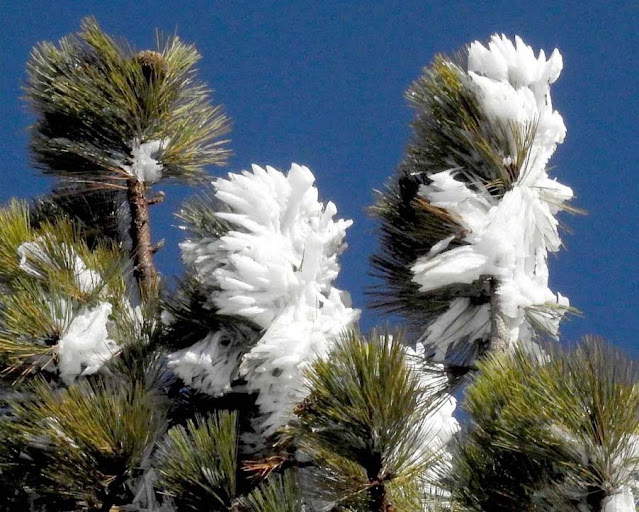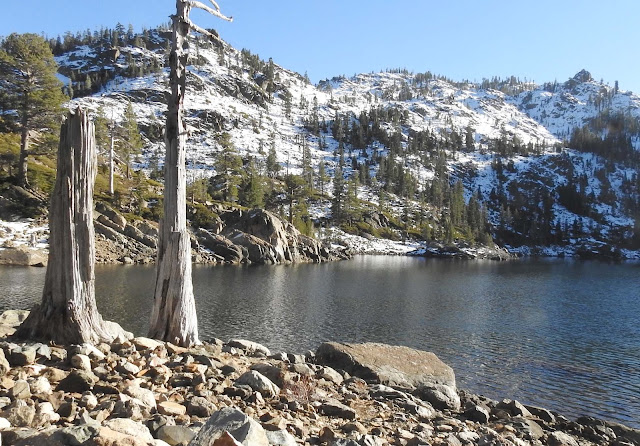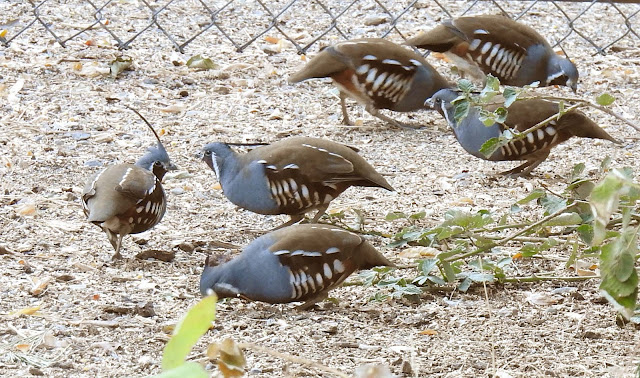Common Goldeneyes (2 adult males & 1 juvenile)
Bucephala clangula
This past week we had 3 days of rain with a total rainfall of 2.20". The river is up and everything is soaked! Yahoo!!! We haven't got any measurable snow yet this year, but the Lakes Basin is blanketed. This week, I counted 3 groups of Common Goldeneye ducks, ranging from 6-12 in number, in a 7 mile, mid-elevation, section of the river. They were probably driven down from the Lakes Basin by the recent snows!
In California, Common Goldeneyes are the only ducks that regularly spend the winter on rivers and lakes above the foothills of the western Sierra. They are diving ducks and eat fish, aquatic vertebrates, seeds, and tubers. When diving, they keep their wings pressed to their sides underwater, and swim with their webbed feet! This species can fly up to 40 mph, and the wind "whistles" through their wing feathers! They will spend the rest of the winter here. In the spring they will leave for their northern breeding grounds in Alaska and Canada.

Common Goldeneyes (1 adult female & 1 juvenile)
Adult males have bright white dots on their greenish-black heads (see top photo) and white bodies. Juvenile males and females both have brown heads and gray bodies. Adult females have brown heads, without a white spot, and gray bodies, but the tip of their black bill is yellow.
Common Goldeneyes - Bucephala clangula
They were so beautiful to watch, as they swam in a close-knit group along the river! Both males and females have golden eyes!
Pine Siskin - Spinus pinus
Fast moving flocks of Pine Siskins were landing and feeding on the seeds in the female Alder cones this morning! The flock I saw was probably 50+ Siskins in number!!! They were amazing to watch, flying and landing in unison, hurriedly feeding, and then suddenly all taking off again!
Lately I've been reading about how flocks of birds navigate as a group. Here's what I learned from https://www.audubon.org/magazine/march-april-2009/how-flock-birds-can-fly-and-move-together.
Each
bird in a flock observes and responds to the movement of no more than seven neighboring
birds. Mainly birds to its sides and to
its front! This response by one bird creates
a chain reaction that ripples quickly through the rest of the flock. Members of a flock do not stay an exact
distance away from each other, like dots on a grid. This space fluctuates, with the priority
being to maintain the space ahead of each individual, not so much the space to
the sides or above and below. This "ripple effect" explains some of
the flight behavior in flocks, but doesn't explain everything. Researchers believe that other factors affect
the behavior of flocks, such as sound or even rushing air from a close
neighbor. There is still a lot to learn and discover!
Pine Siskins (the gray shapes) & Mountain Alder cones (insert)
Spinus pinus - Alnus incana ssp. tenuifolia
Pine Siskins are named for their preference for pine and other conifer seeds. They will hang from the tips of branches to glean seeds from the cones. They also feed on the ground for a wide variety of grass and shrub seeds, garden vegetable leaves and stems, and insects. Sap in tree trunk holes, that Sapsuckers have made, can also be part of their diet! They will also ingest minerals along the sides of roads! They range widely and erratically in response to seed crops. Their main food in winter is cone seeds and tree buds. Locally they've been eating the seeds from this year's alder cones.
When food is plentiful they will store lots of seeds in their crop, which gets them through cold winter nights. Unlike hummingbirds, that go into a state of torpor overnight, Pine Siskins ramp up their metabolic rate to stay warm at night! They also put on a layer of fat for winter! I love watching these little birds and hearing their busy chatter as they forage and perch in the trees! They travel in small to large flocks all year. One morning two winters ago, 122 of them landed and feasted on thistle seeds that I had scattered on the snow!!!
One of my favorite descriptions of birds in small flocks, like these Pine Siskins, is the following poem by Brian O'Hara.
THE SPARROWS
Away and out from branches,
a handful of pebbles thrown,
together arch and wing their way
and down to earth again.
Your oneness amazes me,
that anticipates and follows movement.
Together forever together.
Drinking at fountains, rolling in dust,
chasing insects,
weightless, defying gravity.
Riders of wind waves,
writing graceful lines with feathers, invisible.
The innocence of children playing.
Flute in the morning, under the eaves at night.
from Sparrowhawk by Brian O'Hara ©1990
Window Frost
Frosty Mornings!
It's been cold at night lately, in the 20's! In the mornings if it's not raining, there's frost on the car windows, as well as on the leaves, grasses, and twigs that are on the ground. It can be surprisingly beautiful! Especially if you look closely!
Water vapor, when frozen, forms crystals that begin as hexagonal prisms. These prisms can be flat small plates, or tall thin columns. These hexagonal prisms will change in shape as temperatures fluctuate, and/or particles of dirt/dust combine with the water vapor. There are several different kinds of frost. The most common are radiation/hoarfrost, advection, window, and rime.
"Frost is water vapor, or water in a gas form, that becomes solid. Frost usually forms on objects like cars, windows, and plants that are outside in air that is saturated, or filled, with moisture.
Frost forms when an outside surface cools past the dew point. The dew point is the point where the air gets so cold, the water vapor in the atmosphere turns into liquid. This liquid freezes. If it gets cold enough, little bits of ice, or frost, form. The ice is arranged in the form of ice crystals. Frost usually forms at night, when the air temperature is cooler. Once the sun rises and warms the air around the frosted object, frost melts quickly.
Radiation/Hoarfrost: When frost forms as minute ice crystals covering the ground, we just call it all frost. But sometimes the frost grains grow larger and are called hoarfrost crystals. Good hoarfrost is not that uncommon if you watch for it. Hoarfrost grows whenever it's cold outside and there is a ample source of water vapor nearby.
Surface Hoar: The most common form of hoarfrost is called surface hoar. This consists of ice crystals that form on top of snow banks, usually overnight. The sparkles you see coming from a field of snow are often reflections off the facets of surface hoar crystals. Surface hoar typically forms when a snowbank warms up during the day and is then cooled again overnight. The night air cools the surface of the snowbank more than the inside, so that water can evaporate from inside the snowbank and recrystalize on the surface. By morning the snowbank is covered with a layer of faceted ice crystals, and they can be quite large. These usually melt again once the sun comes up, so the best time to find surface hoar is early in the morning.
Advection Frost forms when a cold wind blows over the branches of trees, poles, and other surface, and forms a collection of small ice spikes.
Window Frost forms when a pane of glass is exposed to below-freezing temperatures on the outside and moist air on the inside. Water vapor from the air condenses as frost on the inside surface of the window. Window frost often makes elaborate patterns as the crystal growth is strongly influenced by the window surface. Scratches, residual soap streaks, etc., can all change the way the crystals nucleate and grow.
Rime Frost is frost that forms quickly, usually in very cold, wet climates. Rime also forms in windy weather. Rime sometimes looks like solid ice. Snow crystals accumulate rime when they collide with water droplets in the clouds. When the clouds are near the ground you have fog, and sometimes the fog is made from supercooled water droplets -- water at a temperature below the freezing point. Then the droplets freeze on contact to anything they hit, sometimes yielding some bizarre, wind-driven rime formations."
Does lichen have the same relationship with rain/water that moss has?
What are the deer doing?
What's happening in the Lakes Basin?
Check back next week for the answers to these questions and more!
Unfortunately you can no longer sign up to get my blog emailed to you.
Something changed at Blogspot.com. Oh well... However, my blog looks better if you just go to northyubanaturalist.blogspot.com, rather than get the emailed version. I suggest that you just bookmark my blog and visit it every Sunday afternoon!
Your questions and comments are greatly appreciated!
Please email me at northyubanaturalist@gmail.com.
















































